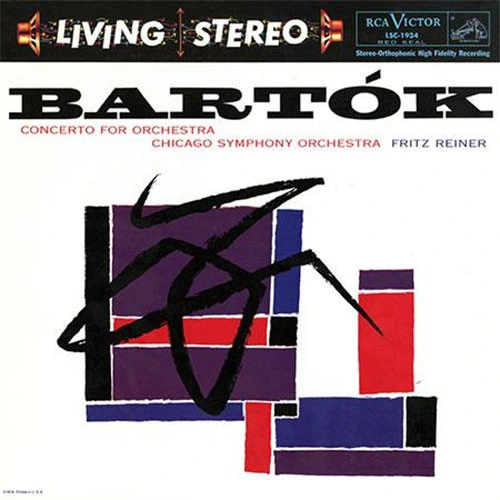180g Virgin Vinyl High Quality Pressing!
Pure Analogue Audiophile Mastering!
Between Bartóks Rhapsody for Piano and his First Piano Concerto lie 22 years of development, a struggle to find subject matter, form and his own musical language. While the Rhapsody from 1904 is dominated by a late-Romantic tone, which delights in a free, craggy and capricious feast of affable harmonies, the Piano Concerto reflects contemplation and a delving into the formal strictness of the classical three-movement concerto form. Rather less concerto-like and unconventional is, however, the use of the piano as a percussion instrument, which after just a few bars on the winds, hammers out an unrelenting staccato against the harsh and dissonant orchestra. In the slow movement too the piano is predominantly employed as a percussion instrument that, like the pendulum of a clock, rhythmically bulldozes on against the cheerless, bleak winds. Wild emotion predominates in the Finale. Stormy, insistent figures in the piano are answered by the orchestra with animated blows, but the quick flashes of melodies cannot establish themselves and are slashed to pieces as if caught in a storm.
This uncompromising severity presents an enormous challenge that is mastered with aplomb by Géza Anda and the RSO Berlin under Ferenc Fricsay. Bartóks musical language is milder and more accessible in his Second and Third Piano Concertos.
On Bartok's Rhapsody (Side B): "It's a virtuosic work thoroughly grounded in late 19th century Romanticism and unidentifiable at Bartok, but well worth knowing." Andrew Quint, The Absolute Sound, 4.5/5 Music, 4/5 Sonics.
Features:
180g Virgin Vinyl
High Quality Pressing
Pure Analogue Audiophile Mastering
Musicians:
Geza Anda, piano
Radio Symphony Orchestra Berlin
Ferenc Fricsay, conductor
Selections:
Bela Bartok (1881-1945)
Side A:
Piano Concerto No. 1 for piano and orchestra
1. Satz: Allegro moderato - Allegro
2. Satz: Andante
3. Satz: Allegro molto
Side B:
Rhapsody for Piano and Orchestra, Op. 1
Recording: October 1960 at Jesus-Christus-Kirche, Berlin, by Günter Hermanns
Pure Analogue Audiophile Mastering!
Between Bartóks Rhapsody for Piano and his First Piano Concerto lie 22 years of development, a struggle to find subject matter, form and his own musical language. While the Rhapsody from 1904 is dominated by a late-Romantic tone, which delights in a free, craggy and capricious feast of affable harmonies, the Piano Concerto reflects contemplation and a delving into the formal strictness of the classical three-movement concerto form. Rather less concerto-like and unconventional is, however, the use of the piano as a percussion instrument, which after just a few bars on the winds, hammers out an unrelenting staccato against the harsh and dissonant orchestra. In the slow movement too the piano is predominantly employed as a percussion instrument that, like the pendulum of a clock, rhythmically bulldozes on against the cheerless, bleak winds. Wild emotion predominates in the Finale. Stormy, insistent figures in the piano are answered by the orchestra with animated blows, but the quick flashes of melodies cannot establish themselves and are slashed to pieces as if caught in a storm.
This uncompromising severity presents an enormous challenge that is mastered with aplomb by Géza Anda and the RSO Berlin under Ferenc Fricsay. Bartóks musical language is milder and more accessible in his Second and Third Piano Concertos.
On Bartok's Rhapsody (Side B): "It's a virtuosic work thoroughly grounded in late 19th century Romanticism and unidentifiable at Bartok, but well worth knowing." Andrew Quint, The Absolute Sound, 4.5/5 Music, 4/5 Sonics.
Features:
180g Virgin Vinyl
High Quality Pressing
Pure Analogue Audiophile Mastering
Musicians:
Geza Anda, piano
Radio Symphony Orchestra Berlin
Ferenc Fricsay, conductor
Selections:
Bela Bartok (1881-1945)
Side A:
Piano Concerto No. 1 for piano and orchestra
1. Satz: Allegro moderato - Allegro
2. Satz: Andante
3. Satz: Allegro molto
Side B:
Rhapsody for Piano and Orchestra, Op. 1
Recording: October 1960 at Jesus-Christus-Kirche, Berlin, by Günter Hermanns



 Turntable Accessories
Turntable Accessories Headphone Accessories
Headphone Accessories Cable Accessories
Cable Accessories Vinyl Accessories
Vinyl Accessories Compact Disc Accessories
Compact Disc Accessories









